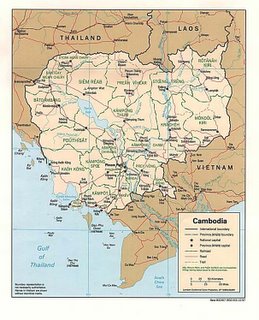Cambodia and Tourism

Cambodia Travel Guide
For many travelers the allure of an un-spoilt and little-explored country is irresistible. Emerging from a violent past of human rights atrocities, war and political instability, Cambodia is recovering from its past and slowly becoming a top destination on the South East Asian travel map. The magnificent temples of the 'Lost City' of Angkor are an irresistible attraction that, despite the dangers of unexploded landmines and the threat of rural banditry, is a must-see for any determined traveler.
Modern day Cambodia is the successor kingdom of the powerful Khmer Empire which ruled most of what is today Vietnam, Laos and Thailand from the 9th to 14th centuries. Although the country does not have the same volume of attractions as some of its neighbors, the Cambodian people are incredibly friendly, providing a welcoming embrace for travelers.
This fact in itself is amazing given the suffering that Cambodians had to endure during the three-and-a-half year reign of Pol Pot, which resulted in the deaths of an estimated two million people. The Khmer Rouge period under Pol Pot's leadership, altered the face of the country. Overnight cities were emptied and property destroyed, the economy was left in shatters and so were the lives of countless families. This period between 1975 and 1979 represents a particularly dark period in the nation's history. Travelers to Cambodia can now enjoy many wonderful aspects of this country. Pleasurable moments can be had in the snatches of friendly conversations, in the tranquility ushered in by Buddhist prayer or in the sounds of workers in the rice paddies. One can also search for the charms of the French-era capital city Phnom Penh, visit the tragic horrors of the Killing Fields or drift past sleepy riverside locations on a boat.
The scenery is beautiful an abundant, shaped by landscapes of lush green forests and jungles, banana plantations, agricultural fields and mighty rivers. People here live modest and simple lifestyles and the populaces are largely rural. It is not a place of fast and efficient transport or luxurious hotels and resort living. Infrastructure is basic (much of it having been destroyed) and traveling between destinations can be quite an experience - fun for some and frustrating for others. The country's world-class attractions and less-explored reaches, golden beaches and islands beckon the enterprising travelers, and make this unique destination the equivalent of a pearl in an unopened oyster.
Cambodia Basics
Time: GMT +7.
Electric: 220 volts, 50Hz. Travelers should be aware that power cuts are frequent and, outside the capital, electricity is generally only available in the evenings.
Language: Khmer is the official language. French is also spoken, but English is fast becoming popular with the younger generation.
Health: There are a number of health risks associated with travel to Cambodia and travelers are advised to seek the latest medical advice on vaccinations and precautions especially regarding typhoid, cholera, malaria, hepatitis B and polio, at least three weeks before traveling. Malaria prophylaxis is recommended for all areas except Phnom Penh, around Lake Tonle Sap and the Angkor temple complex. Dengue fever, transmitted by mosquitoes, is prevalent especially in heavily populated areas. There have been recent outbreaks of Avian Influenza with four deaths in Cambodia, and although the risk of contracting the disease is slight, travelers should avoid contact with domestic, wild and caged birds and ensure that all poultry products are well cooked. Diarrhoea is the number one ailment afflicting travelers. Visitors should assume that the water is not safe to drink; bottled water is widely available. Avoid uncooked meat, unpeeled fruit, salads and food sold by street vendors, and don't drink beverages with ice. Medical facilities are poor, except for a few expensive private hospitals in Phnom Penh. Treatment must be paid for with cash and health insurance is essential.
Tipping: Tips are not expected, but are welcomed in restaurants and hotels. Hotels often add a 10% service charge to the bill, but small amounts for personal services are appreciated. Tour guides should be tipped.
Safety: There is some risk from terrorism due to continuing terrorist activity in South East Asia, and travellers are advised to be vigilant in public places and areas frequented by foreigners. Cambodia remains one of the most heavily land-mined countries in the world. Visitors should travel with a local guide and never stray off the main paths. It is not advisable to travel anywhere at night. Caution should be taken in the capital, Phnom Penh, especially at night, as street crime is a problem, and there have been several incidents involving foreigners around popular tourist nightspots in Phnom Penh.
Customs: Permission should be sought before snapping pictures of people, particularly monks. Avoid touching someone on the head as it is considered the most sacred part of a person's body. Women should wear modest clothing, preferably a long skirt or loose-fitting trousers. Communications: The international access code for Cambodia is +855. The outgoing code is 001 followed by the relevant country code (e.g. 00144 for the United Kingdom). Domestic and international calls can be made at post offices or telecom offices in most towns. Three mobile phone operators cover Phnom Penh and other major cities. The country uses GSM networks, so US phones are not compatible. Mobile phones can be rented at Pochentong International Airport on arrival. Internet cafes are available and inexpensive in Siem Reap and Phnom Penh. Internet phones are available in Siem Reap and provide a cheaper alternative for international calls. Duty Free: Travelers to Cambodia are allowed to enter the country with the following items without incurring customs duty: 200 cigarettes or equivalent of cigars or tobacco; and 1 bottle of spirits. Cambodian customs authorities may enforce strict regulations on the import or export of drugs, firearms, antiquities and ivory.
Cambodia Health Overview
There are a number of health risks associated with travel to Cambodia and travelers are advised to seek the latest medical advice on vaccinations and precautions especially regarding typhoid, cholera, malaria, hepatitis B and polio, at least three weeks before traveling. Malaria prophylaxis is recommended for all areas except Phnom Penh, around Lake Tonle Sap and the Angkor temple complex. Dengue fever, transmitted by mosquitoes, is prevalent especially in heavily populated areas. There have been recent outbreaks of Avian Influenza with four deaths in Cambodia, and although the risk of contracting the disease is slight, travelers should avoid contact with domestic, wild and caged birds and ensure that all poultry products are well cooked. Diarrhea is the number one ailment afflicting travelers. Visitors should assume that the water is not safe to drink; bottled water is widely available. Avoid uncooked meat, unpeeled fruit, salads and food sold by street vendors, and don't drink beverages with ice. Medical facilities are poor, except for a few expensive private hospitals in Phnom Penh. Treatment must be paid for with cash and health insurance is essential.
View information on diseases: Cholera, Hepatitis B, Malaria, Typhoid fever
Cholera
Cause: Vibrio cholerae bacteria, serogroups O1 and O139.
Transmission: Infection occurs through ingestion of food or water contaminated directly or indirectly by faeces or vomit of infected persons. Cholera affects only humans; there is no insect vector or animal reservoir host.
Nature of the disease: An acute enteric (intestine) disease varying in severity. Most infections are asymptomatic (i.e. do not cause any illness). In mild cases, diarrhoea occurs without other symptoms. In severe cases, there is sudden onset of profuse watery diarrhoea with nausea and vomiting and rapid development of dehydration. In severe untreated cases, death may occur within a few hours due to dehydration leading to circulatory collapse.
Geographical distribution: Cholera occurs mainly in poor countries with inadequate sanitation and lack of clean drinking water and in war-torn countries where the infrastructure may have broken down. Many developing countries are affected, particularly those in Africa and Asia, and to a lesser extent those in central and south America.
Risk for travelers: The risk of cholera is very low for most travelers, even in countries where cholera epidemics occur. Humanitarian relief workers in disaster areas and refugee camps are at risk.Prophylaxis (protective treatment): Oral cholera vaccines for use by travelers and those in occupational risk groups are available in some countries. Precautions: As for other diarrhoeal diseases. All precautions should be taken to avoid consumption of potentially contaminated food, drink and drinking water. Oral rehydration salts should be carried to combat dehydration in case of severe diarrhoea. Source: WHO.
Cause: Hepatitis B virus (HBV), belonging to the Hepadnaviridae.
Transmission: Hepatitis B is transmitted from person to person by contact with infected body fluids. Sexual contact is an important mode of transmission, but infection is also transmitted by transfusion of contaminated blood or blood products, or by use of contaminated needles or syringes for injections. There is also a potential risk of Hepatitis B transmission through other skin-penetrating procedures including acupuncture, piercing and tattooing. Perinatal transmission may occur from mother to baby. There is no insect vector or animal reservoir. Nature of the disease: Many HBV infections are asymptomatic (e.g. causes no symptoms) or cause mild symptoms, which are often unrecognized in adults. When clinical hepatitis results from infection, it has a gradual onset, with anorexia, abdominal discomfort, nausea, vomiting, arthralgia and rash, followed by the development of jaundice in some cases. In adults, about 1% of cases are fatal. Chronic HBV infection persists in a proportion of adults, some of whom later develop cirrhosis and/or liver cancer.
Geographical distribution: Worldwide, but with differing levels of endemicity. In north America, Australia, northern and western Europe and New Zealand, prevalence of chronic HBV infection is relatively low (less than 2% of the general population). Risk for travelers: Negligible for those vaccinated against hepatitis B. Unvaccinated travelers are at risk if they have unprotected sex or use contaminated needles or syringes for injection, acupuncture, piercing or tattooing. An accident or medical emergency requiring blood transfusion may result in infection if the blood has not been screened for HBV. Travelers engaged in humanitarian relief activities may be exposed to infected blood or other body fluids in health care settings. Prophylaxis (protective treatment): Vaccination.
Precautions: Adopt safe sexual practices and avoid the use of any potentially contaminated instruments for injection or other skin-piercing activity. Source: WHO.
Malaria
General considerations: Malaria is a common and life-threatening disease in many tropical and subtropical areas. It is currently endemic in over 100 countries, which are visited by more than 125 million international travelers every year. Each year many international travelers fall ill with malaria while visiting countries where the disease is endemic, and well over 10,000 fall ill after returning home. Fever occurring in a traveler within three months of leaving a malaria-endemic area is a medical emergency and should be investigated urgently.
Cause: Human malaria is caused by four different species of the protozoan parasite Plasmodium: Plasmodium falciparum, P. vivax, P. ovale and P. malariae.
Transmission: The malaria parasite is transmitted by various species of Anopheles mosquitoes, which bite mainly between sunset and sunrise. Nature of the disease: Malaria is an acute febrile illness with an incubation period of 7 days or longer. Thus, a febrile illness developing less than one week after the first possible exposure is not malaria. The most severe form is caused by P. falciparum, in which variable clinical features include fever, chills, headache, muscular aching and weakness, vomiting, cough, diarrhoea and abdominal pain; other symptoms related to organ failure may supervene, such as: acute renal failure, generalized convulsions, circulatory collapse, followed by coma and death. It is estimated that about 1% of patients with P. falciparum infection die of the disease. The initial symptoms, which may be mild, may not be easy to recognize as being due to malaria. It is important that the possibility of falciparum malaria is considered in all cases of unexplained fever starting at any time between the seventh day of first possible exposure to malaria and three months (or, rarely, later) after the last possible exposure, and any individual who experiences a fever in this interval should immediately seek diagnosis and effective treatment. Early diagnosis and appropriate treatment can be life-saving. Falciparum malaria may be fatal if treatment is delayed beyond 24 hours. A blood sample should be examined for malaria parasites. If no parasites are found in the first blood film but symptoms persist, a series of blood samples should be taken and examined at 6-12-hour intervals. Pregnant women, young children and elderly travellers are particularly at risk. Malaria in pregnant travellers increases the risk of maternal death, miscarriage, stillbirth and neonatal death. The forms of malaria caused by other Plasmodium species are less severe and rarely life-threatening. Prevention and treatment of falciparum malaria are becoming more difficult because P. falciparum is increasingly resistant to various antimalarial drugs. Of the other malaria species, drug resistance has to date been reported for P. vivax, mainly from Indonesia (Irian Jaya) and Papua New Guinea, with more sporadic cases reported from Guyana. P. vivax with declining sensitivity has been reported for Brazil, Colombia, Guatemala, India, Myanmar, the Republic of Korea, and Thailand. P. malariae resistant to chloroquine has been reported from Indonesia.
Geographical distribution: The risk for travelers of contracting malaria is highly variable from country to country and even between areas in a country. In many endemic countries of Latin America and the Caribbean, Asia and the Mediterranean region, the main urban areas, but not necessarily the outskirts of towns, are free of malaria transmission. However, malaria can occur in main urban areas in Africa and India. There is usually less risk of the disease at altitudes above 1,500 metres, but in favourable climatic conditions it can occur at altitudes up to almost 3,000 metres. The risk of infection may also vary according to the season, being highest at the end of the rainy season. There is no risk of malaria in many tourist destinations in South-East Asia, Latin America and the Caribbean. Source: WHO.
Typhoid fever
Cause: Salmonella typhi, the typhoid bacillus, which infects only humans. Similar paratyphoid and enteric fevers are caused by other species of Salmonella, which infect domestic animals as well as humans.
Transmission: Infection with typhoid fever is transmitted by consumption of contaminated food or water. Occasionally direct faecal-oral transmission may occur. Shellfish taken from sewage-polluted beds are an important source of infection. Infection occurs through eating fruit and vegetables fertilized by night soil and eaten raw, and milk and milk products that have been contaminated by those in contact with them. Flies may transfer infection to foods, resulting in contamination that may be sufficient to cause human infection. Pollution of water sources may produce epidemics of typhoid fever, when large numbers of people use the same source of drinking water.
Nature of the disease: Typhoid fever is a systemic disease of varying severity. Severe cases are characterized by gradual onset of fever, headache, malaise, anorexia and insomnia. Constipation is more common than diarrhoea in adults and older children. Without treatment, the disease progresses with sustained fever, bradycardia, hepatosplenomegaly, abdominal symptoms and, in some cases, pneumonia. In white-skinned patients, pink spots (papules), which fade on pressure, appear on the skin of the trunk in up to 50% of cases. In the third week, untreated cases develop additional gastrointestinal and other complications, which may prove fatal. Around 2-5% of those who contract typhoid fever become chronic carriers, as bacteria persist in the biliary tract after symptoms have resolved.
Geographical distribution: Worldwide. The disease occurs most commonly in association with poor standards of hygiene in food preparation and handling and where sanitary disposal of sewage is lacking.
Risk for travelers: Generally low risk for travelers, except in parts of north and west Africa, in south Asia and in Peru. Elsewhere, travelers are usually at risk only when exposed to low standards of hygiene with respect to food handling, control of drinking water quality, and sewage disposal. Prophylaxis (protective treatment): Vaccination.
Precautions: Observe all precautions against exposure to foodborne and waterborne infections. Source: WHO.
Cambodia Climate and Weather 
Cambodia's climate can generally be described as tropical with seasonal monsoons. There are two distinct seasons, the rainy and dry. Temperatures during the rainy season, between June and October, average 80-95°F (27-35°C). The dry season is characterized by cool months, November to February, with temperatures averaging 80-95°F (17-27°C) and hot months, from March till May, which sees temperature range between 84-100°F (29-38°C).
Cambodia Currency
Money: Riel (KHR) is the official currency and is divided into 100 sen. Foreign currency is difficult to exchange with the exception of US Dollars. Most transactions require cash. US dollars and Thai Baht are accepted, although smaller transactions are usually done in riel. A torn US dollar note renders it useless. Credit cards are only accepted in a limited number of tourist hotels and restaurants in Phnom Penh and larger towns. There are a few ATMs in Phnom Penh, but they shouldn't be relied upon as a source of money; travelers’ cheques in US dollars or sterling can be cashed at a limited number of banks and larger hotels.
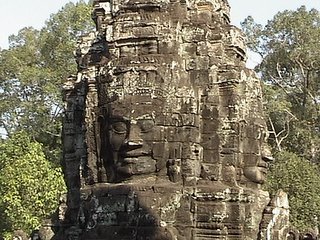
Cambodia Passport & Visa Requirements:
Entry requirements for Americans: US travelers must have a valid passport and holiday or business visa, which can be obtained on arrival for one month. Entry requirements for UK nationals: UK travelers must have a valid passport and a tourist or business visa, which can be obtained on arrival for one month.
Entry requirements for Canadians: Canadians must have a valid passport and a visa is required. A visa can be obtained on arrival, if the purpose of travel is for touristic or business purposes for up to one month.
Entry requirements for Australians: Australians must have a valid passport and a visa is required. A visa can be obtained on arrival, if the purpose of travel is for touristic or business purposes for up to one month.
Entry requirements for South Africans: South African nationals must have a valid passport and require a holiday or business visa, which can be obtained on arrival for one month. Entry requirements for New Zealanders: New Zealanders must have a valid passport and require a business or tourist visa, which can be obtained on arrival for one month.
Entry requirements for Irish nationals: Irish nationals must have a valid passport and require a holiday or business visa, which can be obtained on arrival for one month.
Passport/Visa Note: All visitors must have a return or onward ticket in addition to documents for further travel, and sufficient funds to cover their stay. A passport valid for at least six months from date of entry is required by all.
Note: Passport and visa requirements are liable to change at short notice. Travelers are advised to check their entry requirements with their embassy or consulate.

1. Phnom Penh Legend has it that in 1372, a local widow named Penh, discovered four Buddha statues that had been washed up by the waters from the Mekong River. She saw them as bearers of good fortune and erected a temple on the hill to house them, and so the city grew around this structure, known as the Hill of Penh (Phnom Penh).
Once considered to be the loveliest of Indochina's French-built cities, this untidy capital sprawls at the confluence of the Mekong, Bassac and Tonlé Sap Rivers. Concrete buildings in need of repair, unsealed roads riddled with potholes and a confusion of boulevards crammed with traffic, all make uninviting first impressions. Traces of Khmer and colonial eras can be found in the little details, redeeming those first hasty conclusions. These can be found in the heart of the city where French villas and street-side cafes perch along tree-lined boulevards and the occasional majestic Khmer building catches the eye. Phnom Penh has a number of Wats (temple-monasteries), museums and other places of interest in and around the city, as well as sunset cruises on the Mekong and Tonlé Sap Rivers, and a bustling market place. There has also been a recent boom of new hotels, restaurants, bars and nightclubs sprouting up through the city and a nightlife that promises fun and flavour.

2. The Royal Palace
This is the principal attraction of the city and contains the best examples of 20th-century Khmer architecture. The Royal Palace is the official residence of King Norodom Sihanouk. Although off-limits to the public, several buildings within the gleaming yellow walls of the compound can be visited. Set among the perfectly maintained gardens is the exquisite Throne Hall, the Elephant Pavilion where the king’s elephants were kept, the Royal Treasury and the Chan Chaya Pavilion, made especially for performances of classical Cambodian dance. The highlight of the compound, the Silver Pagoda, takes its name from the floor of the temple, which is completely covered in silver tiles. The internal walls are decorated with frescoes depicting episodes of the Ramayana myth, painted in 1903 by 40 Khmer artists. Also called the Pagoda of the Emerald Buddha, the magnificent baccarat crystal image of the Emerald Buddha sits in the centre on a gilt pedestal. There are other intricately carved Buddha images on display, notably the life-size solid gold statue that stands in front of the pedestal, decorated with 9,584 diamonds.
3. National Museum 
The museum houses the country’s most important collection of ancient Cambodian culture and Khmer art. It is made up of four galleries containing relics, sculpture, art and crafts covering history from the pre-Angkor period (4th century) until the present. The pieces are arranged in chronological order and the collection continues to grow as new treasures previously hidden from the Khmer Rouge are discovered. There are also original relics and sculptures from the temples of Angkor.
Opening time: Daily except Monday from 8am to 11am and 2.30pm to 5pm; Admission: US$2
4. Tuol Sleng Museum
When the Khmer Rouge came into power in 1975 they commandeered and converted a secondary school into a primitive prison where they detained and tortured anyone suspected of anti-revolutionary behaviors. Between 1975 and 1979 an estimated 20,000 victims were imprisoned in Security Prison 21, or S21, as it was known. The museum was established after the Vietnamese invasion of Cambodia and today it appears exactly as the fleeing Khmer Rouge left it, and serves as a testimony to the crimes and atrocities of the organization. It is a tremendously depressing experience, and the pictures, instruments of torture and bloodstained walls give a thorough idea of the extent of the pain and horror borne by the Cambodian people. Thousands of victims were transported from here to the extermination camp outside.
Opening time: Daily 8am to 11.30am and 2.30pm to 5pm; Admission: US$2
5. Choeung Ek
Choeung Ek was the extermination camp where the prisoners from S21 (now the Tuol Sleng Museum) were transported to and executed. Also known as the Killing Fields after the movie of the same name, about 17,000 people were buried here in mass graves. A tall Memorial Stupa was constructed to commemorate the dead and more than 8,000 skulls are displayed behind the glass. At the entrance, a handwritten sign in Khmer and English summarizes the atrocities caused by the Khmer Rouge.
Opening time: Daily except Monday from 8.30am to 4.30pm; Admission: US$2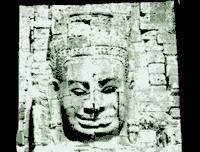 The Temples of Angkor: The famous Temples of Angkor are Cambodia's biggest tourist attraction. Situated close to the town of Siem Reap, the former capital and heart of the ancient Khmer Empire was built between the 9th and 13th centuries, and in an area of over 232 square miles (600 sq km) more than 100 temples have been uncovered. Today they stand as a monument to what was the greatest ancient civilization in South East Asia. The kings of the period built stone temples as a way of asserting their divinity and cities were created around them. Today it is the temples that remain a mere sacred skeleton of what must have been one of the biggest cities of its time. The best-known site is Angkor Wat, the spectacular Hindu temple surrounded by a moat and the biggest monument ever built to religion. Covering an area of 81 hectares (200 acres) the splendour and enormous dimension of the complex.
The Temples of Angkor: The famous Temples of Angkor are Cambodia's biggest tourist attraction. Situated close to the town of Siem Reap, the former capital and heart of the ancient Khmer Empire was built between the 9th and 13th centuries, and in an area of over 232 square miles (600 sq km) more than 100 temples have been uncovered. Today they stand as a monument to what was the greatest ancient civilization in South East Asia. The kings of the period built stone temples as a way of asserting their divinity and cities were created around them. Today it is the temples that remain a mere sacred skeleton of what must have been one of the biggest cities of its time. The best-known site is Angkor Wat, the spectacular Hindu temple surrounded by a moat and the biggest monument ever built to religion. Covering an area of 81 hectares (200 acres) the splendour and enormous dimension of the complex.
Contract more Information:
Tourism of Cambodia, Phnom Penh +855 (0)23 216 666 or http://www.tourismcambodia.com/ Embassy of Cambodia, Washington DC, United States: +1 206 217 0830
Royal Cambodian Embassy, London. Tel: 020 7483 9063
Kingdom of Cambodia's Permanent Mission to the U.N, New York, United States: +1 212 223 0676
Royal Embassy of Cambodia, Canberra, Australia: +61 (0)2 6273 1154
US Embassy, Phnom Penh: +855 (0)23 216 436
British Embassy, Phnom Penh: +855 (0)23 427 124
Australian Embassy, Phnom Penh: +855 (0)23 213 470
Embassy of South Africa, Bangkok, Thailand (also responsible for Cambodia): +66 (0)2 253 8473-6
Irish Embassy, Beijing, China (also responsible for Cambodia): +86 (0)10 6532 2691
New Zealand Embassy, Bangkok, Thailand (also responsible for Cambodia): +66 (0)2 254 2530
Emergencies: 119.






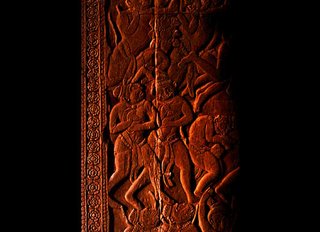




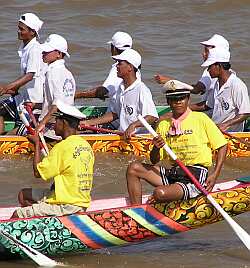
 Weddings
Weddings
